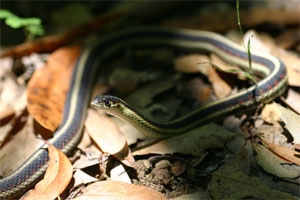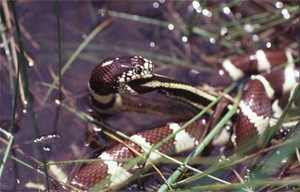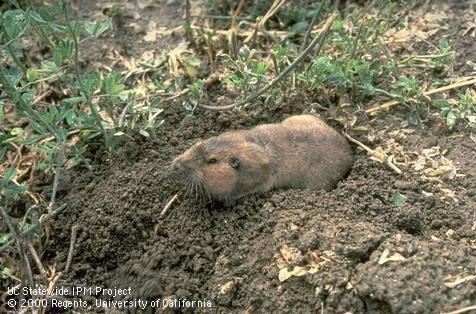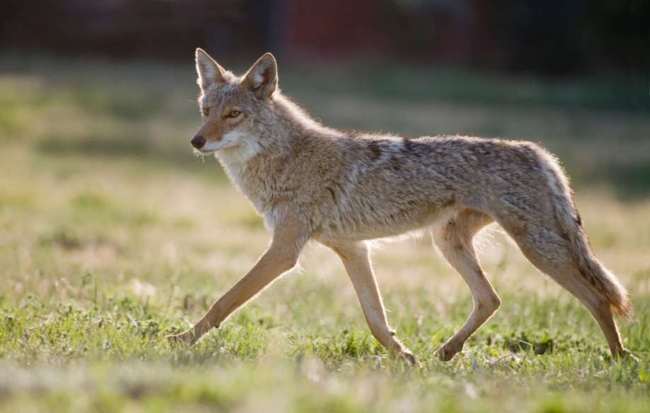
Posts Tagged: vertebrate pest
Goodness Snakes Alive!
Avocado orchards are prime environments for this to happen. For me, it's always startling and amazing to come across an animal that's not expected to be there, but really does belong there as much as I do. Seeing a bobcat, coyote, or deer is not necessarily as startling as seeing a mountain lion or bear. Snakes do surprise me, especially when rooting around the base of a tree looking to see if there is trunk damage. More commonly, I come across
image copyright Michael F. Benard, http://www.mister-toad.com
image copyright Michael F. Benard, http://www.mister-toad.com
The latter will eat rattlesnakes
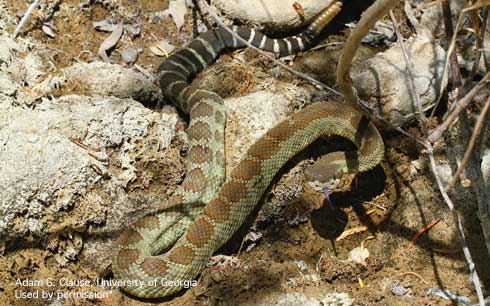
A recent report of a sidewinder in Ojai is a reminder of the people/wildlife interactions that go on all the time in both rural and urban areas. 
Rattlesnakes do show up in coastal orchards frequently. However, it is more commonly a western rattler, not a sidewinder which is more an inhabitant of desert environments. Where did it come from? Did this snake get released into this area? Somebody's pet? Did the recent fires open it up as new habitat? Are other changes going on in the area that make it better habitat? Is this just a one off occurrence?
Whatever, sometimes people and animals get along and sometimes they don't. Remember, if left alone, a snake is likely to move on to another area. Also, recall that most rattlesnake bites occur when inexperienced people try to pick up, pester, move, or kill a rattlesnake. If you would prefer the snake be removed, it is best to call a professional pest or wildlife control operator who specializes in snake removal.
A final course of action may be to kill the rattlesnake. However, this option is not generally recommended since rattlesnakes only bite in self-defense and attempting to kill them can, and sometimes does, result in a person getting bitten. Even a dead rattlesnake can have a bite reflex and is capable of delivering venom.
Rattlesnakes are natural and important predators and automatic killing of them is not recommended any more than is the automatic killing of coyotes, mountain lions, or bears, all of which can very rarely harm people.
Guidelines from the UC IPM Rattlesnake webpage follow:
What Can be Done to Prevent a Bite?
Hands, feet, and ankles are the most common sites for rattlesnake bites. Using some common sense rules can prevent most snakebites.
- Never go barefoot or wear sandals when walking in areas where you cannot clearly see where you are placing your feet. Always wear hiking boots.
- Always stay on paths. Avoid tall grass, weeds, and heavy underbrush where snakes may be present.
- Always look for concealed snakes before picking up rocks, sticks, or firewood.
- Always check carefully around stumps or logs before sitting.
- When climbing, always look before putting your hands in a new location. Snakes can climb walls, trees, and rocks and are frequently found at high altitudes.
- Never grab what appear to be sticks or branches while swimming; rattlesnakes are excellent swimmers.
- Baby rattlesnakes are venomous! They can and do bite. Leave them alone.
- Never hike alone. Always have a buddy to help in case of an emergency. Learn basic lifesaving skills.
- Never handle freshly killed snakes. You may still be bitten.
- Never tease a snake to see how far it can strike. You can be several feet from the snake and still be within striking distance.
- Don't keep rattlesnakes as pets. Many rattlesnake bites occur when people tease or play with their “pet” rattlesnake.
- Teach children to respect snakes and to leave them alone. Curious children who pick up snakes are frequently bitten.
- Always give snakes the right of way!
http://www.californiaherps.com/movies/cccerastes611.mov
http://ipm.ucanr.edu/PMG/PESTNOTES/pn74119.html
Native Reptile Captive Propagation Laws and Regulations
https://nrm.dfg.ca.gov/FileHandler.ashx?DocumentID=35207
garter and king snake images copyright Michael F. Benard, http://www.mister-toad.com
Problems with vermin, coyotes and birds in your grove or specialty crops? Vertebrate Pest Conference Seminar Series Coming Soon!
The Vertebrate Pest Council, with assistance from the Pesticide Applicators Professional Association, will be hosting a series of seminars throughout the state starting in late February. These seminars will be focused entirely on human-wildlife conflict issues. Check out the agendas for each location, and if interested, sign up. They will be providing up to 7.5 hours of CE and lunch will be provided.
Seminar Sessions & Locations:
Petaluma, Feb 28: http://www.papaseminars.com/Images/Seminars/PETALUMAVPCSEMINAR22817_28-2-2017.pdf
Stockton, Mar 2: http://www.papaseminars.com/Images/Seminars/STOCKTONVPCSEMINAR3217_2-3-2017.pdf
San Bernardino, Mar 7: http://www.papaseminars.com/Images/Seminars/SANBERNARDINOVPCSEMINAR3717_7-3-2017.pdf
Fresno, Mar 9: http://www.papaseminars.com/Images/Seminars/FRESNOVPCSEMINAR3917_9-3-2017.pdf
Registration: http://www.papaseminars.com/Seminar

Birds

Coyote irrigation damage

Bird Pest
Experts Converge in March to Discuss Human-Wildlife Conflict Resolution
Wildlife and people have been in the news lately. Perhaps you've heard of coyotes wandering in your neighborhood. You might have also read about how you shouldn't feed wildlife. Did you know they are connected? It's a problem when people feed coyotes either intentionally or unintentionally through uncovered garbage and outdoor pet food. Available food may encourage coyotes to associate closely with humans and to lose their natural fear of us. These interactions will be discussed during a special symposium on urban coyotes at the 27th Vertebrate Pest Conference.
The Vertebrate Pest Conference is held every two years, mostly in California. This year, the meeting will be Monday through Thursday, March 7 to 10 in Newport Beach. Meetings are held in cooperation with the Pesticide Applicators Professional Association (PAPA). The leading authorities with vertebrate management expertise from around the world congregate to present the latest research and extension information. Are you an animal control official, wildlife manager, agricultural producer, pest control adviser, consultant, educator, researcher, or natural resource manager? Then this meeting is for you. California Department of Pesticide Regulation and California Department of Public Health continuing education units are available for participants.
Special symposia include bird management, wild pig management, and urban coyotes. In Cooperative Extension Advisor Niamh Quinn's backyard of extremely urban Southern California, these coyote-human conflicts occur. With over 3 million people in Orange County, 8 state parks and beaches, countless city parks and 19 county parks and wilderness areas, conflicts with urban coyotes are bound to happen. Managing coyotes includes managing people's behavior too.
Quinn says, “We can't manage what we can't measure. This conference provides a unique opportunity to discuss ongoing conflicts, especially those related to urban coyote management. Research is needed to understand urban coyote behavior and if these behaviors are changing as a result of the way we are currently living. Outreach is needed to instruct urbanites on appropriate behavior where coyote conflicts are occurring, and managing coyotes is everyone's concern. We need better and improved strategies for measuring and managing these conflicts.” At the Vertebrate Pest Conference, hear from the experts on the latest information about coyote attacks on humans, coyote conflicts, and several talks on coyote management, including hazing.
Vertebrates are also problematic in commercial agriculture. A 2011 survey of wildlife damage by Cooperative Extension Specialist Roger Baldwin, stated agricultural losses from wildlife damage in California is likely in excess of $1billion annually. Based on the survey results, economic losses were greatest for voles and pocket gophers in alfalfa; and wild pigs, birds, and ground squirrels in nut crops. One talk at the Vertebrate Pest Conference will be a North American overview of bird damage in fruit crops. Other talks cover field rodent repellents, food safety, and trapping.
UC IPM has information on vertebrate pest management for urban and communities, as well as commercial agriculture.

coyote

Avocado damaged by coyote
Vole damage in citrus
Recently a six-year old W. Murcott orchard was evaluated for causes of tree decline. A high percentage of the trees exhibited damage to the bark of the tree generally from the soil line up 6-8 inches. (Fig.2) In some instances the tree had been almost totally girdled. On close inspection of the trunk, an open hole 4-5 inches in diameter was found at the base of the tree. (Fig.3)
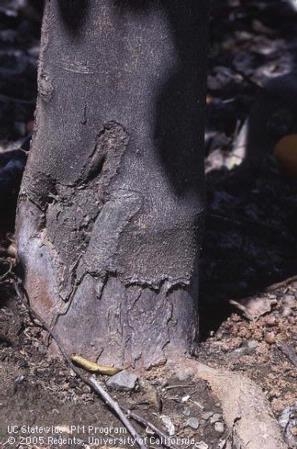
Microtus are often found where there is grass cover. They generally do not invade cultivated crops until the crop is tall enough to provide food and shelter. Meadow mice are active all year round. They forage at any time during the day or night but are chiefly nocturnal. They are usually found in colonies marked by numerous -2-- inch wide surface runways though matted grass. Small piles of brownish feces and short pieces of grass stems along the runways are evidence of activity. The burrows consist of extensive underground tunnels, nest chambers and storage chambers. Home range is typically small, less than a 60 foot radius in the case of “M.californicus”. All meadow mice swim well. Therefore, irrigation ditches will not serve as effective barriers against meadow mice movement into fields. Meadow mice may forage beyond the sheltered runways. Food consists of tubers, roots, seeds, grain, and succulent stems and leaves.
Females breed at 4 to 6 weeks of age with liter size of “M.californicus” averaging around 4. Under natural conditions a female Microtus may produce from 5 to 10 litters a year. The major breeding season corresponds with the season of forage growth. Microtus populations build up to a peak every 3 to 4 years, followed by a rapid decline during the next breeding season. The exact causes of the cycle of buildup and decline are not known, though disease, food shortages, physiological stress from overcrowding, and other factors may be involved. It is assumed that in cultivated areas Microtus populations are permanently based in favorable habitat such as roadsides, canal banks or adjacent noncultivated land. Invasion of cultivated cropland occurs when the population builds up or when the wild habitat becomes unfavorable. Coyotes, badgers, weasels, snakes, hawks, owls, herons and gulls are among the principal predators. It is believed that predators are not able to prevent or control a population eruption because of the birth rate of the fast breeding Microtus population. Meadow mice are classified as nongame mammals by the California Fish and Game Code. Nongame mammals, which are found to be injuring growing crops may be taken at any time or in any manner by the owner. Management: The most effective management options in an orchard situation are a reduction in ground cover and the use of toxic baits. Meadow mice are cover dependent. If cover is the management of choice - typically weed or grass, the cover can be removed from around the base of a tree, this often solves meadow mice problems. In situations where cover removal is not possible or is insufficient to solve the problem, the next best option is the use of toxic baits. Many bait carriers are used (e.g., oat groats, wheat bait). Baits: Crimped oat groats is the most satisfactory bait although crimped whole oats are used (e.g., oat groats, wheat grains, pelletized formulations, etc., but crimped oat groats have typically been most effective). The primary toxicants used for meadow mouse control include zinc phosphide, diphacinone, and chlorophacinone. Directions for management including baiting can be obtained by contacting the Agricultural Commissioner’s Office.
* Portions taken from J.P.Clark Vertebrate Pest Control
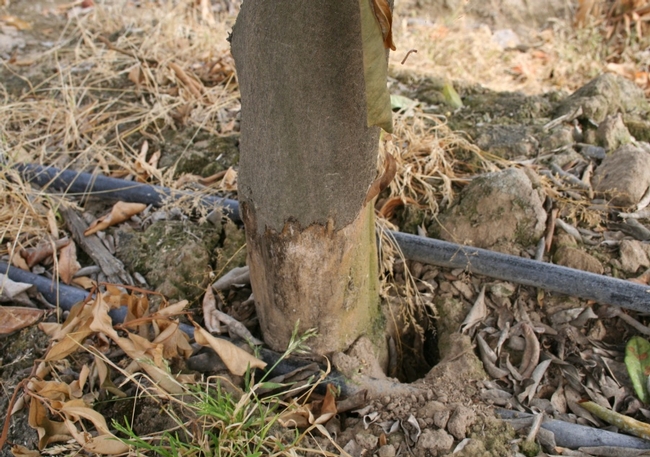
Entrance to burrow (Fig. 2)
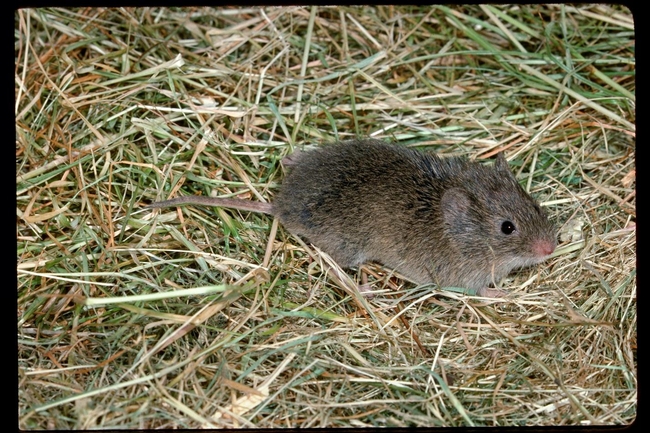
Vole (Fig. 3)

